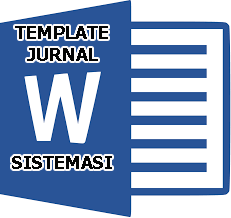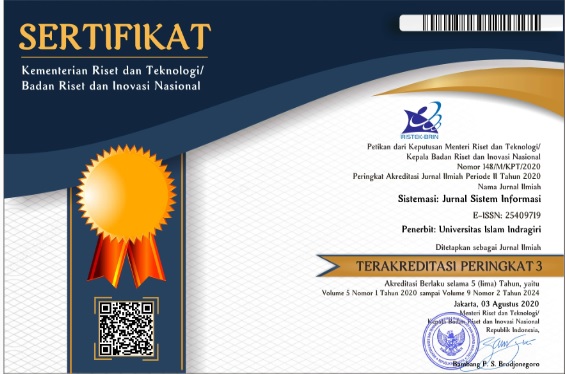Evaluation of Artificial Neural Network Model for Predicting Nitrogen Oxides (NOₓ) Concentration
Abstract
Keywords
Full Text:
PDFReferences
G. Indonesia, “Laporan Kualitas Udara Dunia IQAir 2023: Indonesia Terburuk se- Asia Tenggara,” greenpeace.org, Mar. 19, 2024. https://www.greenpeace.org/indonesia/siaran-pers-2/58036/laporan-kualitas-udara-dunia-iqair-2023-indonesia-terburuk-se-asia-tenggara/ (accessed Mar. 14, 2025).
Rokom, “Polusi Udara Sebabkan Angka Penyakit Respirasi Tinggi,” kemkes.go.id, Apr. 04, 2023. https://sehatnegeriku.kemkes.go.id/baca/rilis-media/20230404/2642721/polusi-udara-sebabkan-angka-penyakit-respirasi-tinggi/ (accessed Mar. 14, 2025).
H. Haruna, L. Lahming, F. Amir, dan A. R. Asrib, “Pencemaran Udara Akibat Gas Buang Kendaraan Bermotor dan Dampaknya terhadap Kesehatan,” UNM Environmental Journals, vol. 2, no. 2, p. 57, Apr. 2019, doi: https://doi.org/10.26858/uej.v2i2.10092.
G. M. Maula, “Efektivitas Implementasi Kebijakan Pengendalian Pencemaran Udara di Indonesia,” Savana: Indonesian Journal of Natural Resources and Environmental Law, vol. 1, no. 2, pp. 145–159, Aug. 2024, doi: https://doi.org/10.25134/savana.v1i2.223.
NOAA, Air Quality Forecasting: A Review of Federal Programs and Research Needs. Boulder, CO: National Oceanic and Atmospheric Administration, 2001. [Online]. Available: https://www.esrl.noaa.gov/csd/aqrsd/reports/forecasting.pdf (accessed: Mar. 15, 2025).
L. S. Rini, O. T. Karya, dan F. Sirait, “Implementasi Jaringan Syaraf Tiruan pada Pendeteksi Keaslian dan Nominal Uang,” Jurnal Teknologi Elektro, vol. 12, no. 2, p. 65, Jul. 2021, doi: https://doi.org/10.22441/jte.2021.v12i2.004.
J. Veri, S. Surmayanti, dan G. Guslendra, “Prediksi Harga Minyak Mentah menggunakan Jaringan Syaraf Tiruan,” MATRIK : Jurnal Manajemen, Teknik Informatika dan Rekayasa Komputer, vol. 21, no. 3, pp. 503–512, Jul. 2022, doi: https://doi.org/10.30812/matrik.v21i3.1382.
S. Agarwal, S. Sharma, S. R., M. H. Rahman, S. Vranckx, B. Maiheu, L. Blyth, S. Janssen, P. Gargava, V. K. Shukla, S. Batra, “Air Quality Forecasting using Artificial Neural Networks with Real Time Dynamic Error Correction in Highly Polluted Regions,” Science of the Total Environment, vol. 735, no. 735, pp. 139454–139454, Sep. 2020, doi: https://doi.org/10.1016/j.scitotenv.2020.139454.
L. Zhang, P. Liu, L. Zhao, G. Wang, W. Zhang, dan J. Liu, “Air Quality Predictions with a Semi-Supervised Bidirectional LSTM Neural Network,” Atmospheric Pollution Research, vol. 12, no. 1, pp. 328–339, Jan. 2021, doi: https://doi.org/10.1016/j.apr.2020.09.003.
S. Agarwa, S. Sharma, R. Suresh, Md. H. Rahman, S. Vranckx, B. Maiheu, L. Blyth, S. Janssen, P. Gargava, V. K. Shukla, S. D. Batra, “Air Quality Forecasting using Artificial Neural Networks with Real Time Dynamic Error Correction in Highly Polluted Regions,” Science of the Total Environment, vol. 735, pp. 139454–139454, Sep. 2020, doi: https://doi.org/10.1016/j.scitotenv.2020.139454.
M. A. Faishol, “Analisis Data Runtun Waktu Prediksi Polusi Udara di Kota Surabaya menggunakan Deep Learning RNN-LSTM,” Thesis, Sepuluh Nopember Institute of Technology, 2020. Accessed: Jan. 31, 2024. [Online]. Available: http://repository.its.ac.id/id/eprint/76659
Y. Karyadi, “Prediksi Kualitas Udara dengan Metoda LSTM, Bidirectional LSTM, dan GRU,” JATISI (Jurnal Teknik Informatika dan Sistem Informasi), vol. 9, no. 1, pp. 671–684, Mar. 2022, doi: https://doi.org/10.35957/jatisi.v9i1.1588.
B. K. Hidayatullah, M. Kallista, and C. Setianingsih, “Prediksi Indeks Standar Pencemaran Udara menggunakan Metode Long Short-Term Memory berbasis Web (Studi Kasus pada Kota Jakarta),” in e-Proceeding of Engineering , Telkom University, Jun. 2022, pp. 1274–1255.
D. Seng, Q. Zhang, X. Zhang, G. Chen, and X. Chen, “Spatiotemporal Prediction of Air Quality Based on LSTM Neural Network,” Alexandria Engineering Journal, vol. 60, no. 2, pp. 2021–2032, Apr. 2021, doi: https://doi.org/10.1016/j.aej.2020.12.009.
Q. Guo, Z. He, S. Li, X. Li, J. Meng, Z. Hou, J. Liu, Y. Chen, “Air Pollution Forecasting using Artificial and Wavelet Neural Networks with Meteorological Conditions,” Aerosol and Air Quality Research, vol. 20, no. 6, pp. 1429–1439, 2020, doi: https://doi.org/10.4209/aaqr.2020.03.0097.
T. Xayasouk, H. Lee, and G. Lee, “Air Pollution Prediction using Long Short-Term Memory (LSTM) and Deep Autoencoder (DAE) Models,” Sustainability, vol. 12, no. 6, p. 2570, Mar. 2020, doi: https://doi.org/10.3390/su12062570.
S. R. Shams, A. Jahani, S. Kalantary, M. Moeinaddini, and N. Khorasani, “The Evaluation on Artificial Neural Networks (ANN) and Multiple Linear Regressions (MLR) Models for Predicting SO2 Concentration,” Urban Climate, vol. 37, p. 100837, May 2021, doi: https://doi.org/10.1016/j.uclim.2021.100837.
L. Zhang, P. Liu, L. Zhao, G. Wang, W. Zhang, and J. Liu, “Air Quality Predictions with a Semi-Supervised Bidirectional LSTM Neural Network,” Atmospheric Pollution Research, vol. 12, no. 1, pp. 328–339, Jan. 2021, doi: https://doi.org/10.1016/j.apr.2020.09.003.
S. Vito, "Air Quality," UCI Machine Learning Repository, 2016. [Online]. Available: https://doi.org/10.24432/C59K5F.
J. Li, H. Izakian, W. Pedrycz, and I. Jamal, “Clustering-based Anomaly Detection in Multivariate Time Series Data,” Applied Soft Computing, vol. 100, p. 106919, Mar. 2021, doi: https://doi.org/10.1016/j.asoc.2020.106919.
D. Musfiroh, U. Khaira, P. E. P. Utomo, and T. Suratno, “Analisis Sentimen terhadap Perkuliahan Daring di Indonesia dari Twitter Dataset menggunakan InSet Lexicon,” MALCOM: Indonesian Journal of Machine Learning and Computer Science, vol. 1, no. 1, pp. 24–33, Mar. 2021, doi: https://doi.org/10.57152/malcom.v1i1.20.
DOI: https://doi.org/10.32520/stmsi.v14i3.4371
Article Metrics
Abstract view : 628 timesPDF - 244 times
Refbacks
- There are currently no refbacks.

This work is licensed under a Creative Commons Attribution-ShareAlike 4.0 International License.









